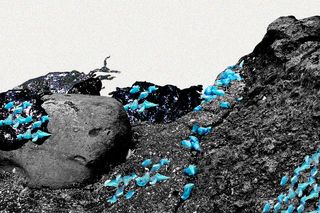
‘Plastitar’ – a Mix of Plastics and Tar – Is the Newest Kind of Pollutant
“No longer is the presence of plastic in the environment limited to microplastics or a bottle in the sea… it’s giving rise to new formations.”

If you haven’t heard of plastitar before, that’s only because it’s a rather recent discovery. As its name suggests, plastitar is a precarious combination of two pollutants — plastic and tar. The existence of this toxic combination came to light when a team of researchers discovered “clumps of hardened tar, dotted with tiny, colorful fragments of plastic,” as The Guardian described it, on the shores of Tenerife, a Spanish island in the Canaries, off West Africa.
Javier Hernández-Borges, an associate professor of analytical chemistry at the University of La Laguna in Tenerife, is credited with coining the term “plastitar.” Published in the journal Science of The Total Environment, a new study details its discovery, formation, and the hazards it may potentially pose to the environment.
“No longer is the presence of plastic in the environment limited to microplastics or a bottle in the sea… Now it’s giving rise to new formations; in this case, one that combines two contaminants,” said Hernández-Borges, who also co-authored the present study, “We’re convinced that this is probably found wherever you see this combination of tar — which unfortunately remains common on beaches — and microplastics.” It is a worrying prospect indeed that plastic is giving rise to other formations.
This heinous amalgamation occurs when the residue from oil spills lingers around, evaporates, and finally, devolves into small balls of thickened tar. These tar balls then stick to rocks on the shore — attracting small bits of plastic that wash ashore. “It acts like Play-Doh… And when waves carrying microplastics or any other kind of marine debris crash on to the rocks, this debris sticks to the tar,” explained Hernández-Borges. Wired termed plastitar as “the unholy spawn of oil spills and microplastics.”
Related on The Swaddle:
Environmental Crisis Looms Over Mauritius After Oil Spill from Shipwreck
Scientists are yet to determine exactly how plastitar threatens the marine ecosystem, but they do have a few intuitive theories. The more obvious threat that plastitar poses is the immediate danger to the species living on the ill-fated rocks that serve as the foundations for this material. As Hernández-Borges says, “If there were algae or whatever, those rocks are completely covered by that, so they will die for sure.”
Besides choking life forms to death, plastitar — being darker than natural rocks — also become extremely hot under the sun. As such, they can potentially raise the temperature on the ground, endangering the life of species dwelling around them. A previous study — conducted in the Henderson Island and Cocos (Keeling) Islands — had found how plastic particles were complicit in raising the temperature of the ground at beaches.
Referring to this finding, Wired reported: “That could imperil sea turtles, whose sex is determined by the temperature of the sand the eggs are laid in — if it gets too hot, they’ll all turn out female, which is no good for the sexual reproduction of a species.” And this is just one species, of course.
Then, of course, there’s also the risk of plastitar leaking toxic chemicals around itself, and perhaps, even into the marine food chain. However, which chemicals will be released and which creatures they can harm hasn’t been ascertained yet. “In some way, [plastitar] may be blocking and inhibiting the development of the ecosystem,” said Hernández Borges.
Related on The Swaddle:
Alarming New Study Finds Baby Poop Is Loaded With Microplastics
At present, what’s also uncertain is just how widespread the plastitar pollution really is. As for tar pollution, as Jennifer Stack, who works with Greater Farallones and Cordell Bank National Marine Sanctuaries and wasn’t involved in the study, said, “[W]e have a lot of ships coming and going. And they’re coming and going through some of the most biodiverse waters in the world… So we are always looking to how to best take care of these waters to prevent oil spills from happening.”
We already know microplastics are everywhere — from the oceans to the soil to sea breeze to even rain and snow. In fact, a 2020 study suggested that plastic pollution in the oceans is likely to triple by 2040.
As such, the threat that plastitar poses to the environment could potentially be immense. The problem, however, is that we’re still trying to understand its impact and its scale. So, it may be a while before we figure out the best way to deal with it. The research aptly describes it as an “unassessed threat” for coastal environments.
As Wired noted, though, “…because someone is going to think it — to be abundantly clear, we should not take inspiration from plastitar to rid the sea of microplastics.” Wise words, perhaps, but given that we’ve allowed plastitar to even become a thing, our wisdom might already be rather questionable.
Devrupa Rakshit is an Associate Editor at The Swaddle. She is a lawyer by education, a poet by accident, a painter by shaukh, and autistic by birth. You can find her on Instagram @devruparakshit.
Related


A Zoo Elephant Named ‘Happy’ Is Not a Legal Person, New York Court Rules
